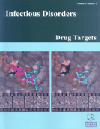- Home
- A-Z Publications
- Infectious Disorders - Drug Targets (Formerly Current Drug Targets - Infectious Disorders)
- Previous Issues
- Volume 9, Issue 4, 2009
Infectious Disorders - Drug Targets (Formerly Current Drug Targets - Infectious Disorders) - Volume 9, Issue 4, 2009
Volume 9, Issue 4, 2009
-
-
Editorial [Hot Topic: Redox Status in the Pathophysiology of Inflammation and Therapeutic Targets (Executive Editor: Mena Soory)]
More LessBy Mena SooryI was able to compile this work due to an enthusiastic response from experts in the field. It encompasses the pathophysiology of inflammation relevant to physiological states, infections, autoimmune and metabolic diseases. This supplement demonstrates the increasing importance of redox-sensitive mechanisms during physiological function, inflammatory pathology, sepsis and carcinogenesis. The relevance of anti-oxi Read More
-
-
-
Oxidative Stress and Mitochondrial Dysfunction in Sepsis: A Potential Therapy with Mitochondria-Targeted Antioxidants
More LessAuthors: Victor M. Victor, Juan V. Esplugues, Antonio Hernandez-Mijares and Milagros RochaSepsis and septic shock are the major causes of death in intensive care units. The prevalent hypothesis regarding the mechanisms of sepsis and septic shock indicates that this syndrome is caused by an excessive defensive and inflammatory response characterised by massive increases in reactive oxygen species (ROS), nitric oxide (NO) and inflammatory cytokines. The consequences of these syndromes are systemic dama Read More
-
-
-
The Implication of Platelet Activating Factor in Cancer Growth and Metastasis: Potent Beneficial Role of PAF-Inhibitors and Antioxidants
More LessAuthors: A. B. Tsoupras, C. Iatrou, C. Frangia and C. A. DemopoulosCancer is one of the leading causes of death in Europe and United States. New blood vessel formation penetrating into solid tumors seems to be required for their growth and metastasis. Several protein growth factors can induce endothelial cell proliferation and angiogenesis, through signal transduction cascades that result in the production of several inflammatory mediators and lipid second messengers such as prostagland Read More
-
-
-
Relevance of Nutritional Antioxidants in Metabolic Syndrome, Ageing and Cancer: Potential for Therapeutic Targeting
More LessBy Mena SooryDiet and nutrition have played an important role in maintaining physiological homeostasis. Recent literature emphasizes potential therapeutic effects of micronutrients found in natural products, indicating positive applications for controlling the pathogenesis of chronic diseases driven by an inflammatory nidus. Nutritional compounds which display anti-inflammatory and antioxidant effects have specific applications in preventi Read More
-
-
-
Redox Status in Periodontal and Systemic Inflammatory Conditions Including Associated Neoplasias: Antioxidants as Adjunctive Therapy?
More LessBy Mena SooryThe aetiopathogenesis of periodontal diseases is initiated by microbial biofilm which could lead to a hyperinflammatory status in aggressive forms of the disease; and cause an imbalance in the redox status, resulting in oxidative stress-induced damage. There is increasing documentation of the link between periodontal and other inflammatory diseases driven by a pro-oxidant profile. This could impose a significant systemic loadi Read More
-
-
-
Role of Free Radicals and Antioxidant Signaling in Skeletal Muscle Health and Pathology
More LessAuthors: Li L. Ji, Maria-Carmen Gomez-Cabrera and Jose VinaSkeletal muscle contraction, growth, differentiation and adaptation are governed by complicated biological mechanisms still being studied intensively. Generation of reactive oxygen and nitrogen species (RS) is one of the most prominent events during contractile activity that could influence muscle function and health. While RS generation is known to cause oxidative stress, activate certain pathogenic pathways and Read More
-
-
-
Antioxidant Nanoparticles for Control of Infectious Disease
More LessAuthors: Shaadi F. Elswaifi, James R. Palmieri, Kevin S. Hockey and Beverly A. RzigalinskiThe new ground being broken by the field of nanotechnology provides us with numerous prospects for treatment and prevention of infectious diseases. Recent reports have demonstrated that several types of nanoparticles act as potent free radical scavengers and antioxidants. Specific nanoconstructs are also reported to have anti-inflammatory activities. Given these properties, the potential application of antioxidant na Read More
-
-
-
The Role of Melatonin in Rheumatic Diseases
More LessAuthors: B. Kalpakcioglu and K. SenelMelatonin is a neurohormone that has attracted a great deal of attention, being frequently investigated in recent years. Due to its wide-spectrum of properties, melatonin has been suggested to be effective with respect to the etiology and treatment of several diseases. Its action on the immune system and antioxidant features has brought interest to this hormone's role in chronic inflammatory diseases. Furthermore, the detectio Read More
-
Volumes & issues
-
Volume 25 (2025)
-
Volume 24 (2024)
-
Volume 23 (2023)
-
Volume 22 (2022)
-
Volume 21 (2021)
-
Volume 20 (2020)
-
Volume 19 (2019)
-
Volume 18 (2018)
-
Volume 17 (2017)
-
Volume 16 (2016)
-
Volume 15 (2015)
-
Volume 14 (2014)
-
Volume 13 (2013)
-
Volume 12 (2012)
-
Volume 11 (2011)
-
Volume 10 (2010)
-
Volume 9 (2009)
-
Volume 8 (2008)
-
Volume 7 (2007)
-
Volume 6 (2006)
Most Read This Month
Article
content/journals/iddt
Journal
10
5
false
en


